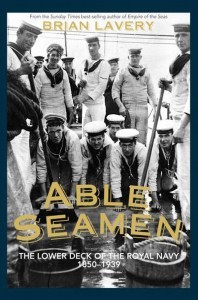 By Brian Lavery, Naval Institute Press, (2012)
By Brian Lavery, Naval Institute Press, (2012)
Reviewed by Capt. Winn Price, USNR (Ret.)
The book jacket informs us that Brian Lavery is a Curator Emeritus of the National Maritime Museum in Greenwich, England. Able Seamen is the second in a series of three studies of enlisted life or ‘the lower deck’ in the Royal Navy. Royal Tars (2010), the first book, covers the period from 875 to 1850. The last of the series, released in 2012, All Hands, addresses life in the lower-decks post-1939. Lavery has over thirty books about the Royal Navy to his credit. The BBC turned Empire of the Seas into a documentary series covering the history of the Royal Navy from the Armada to Jutland. The classic movie Master and Commander benefited from his insights as a historical consultant. So critiquing a book researched and written by Lavery seems to be a fool’s errand, which I suppose explains my opportunity.
As a fresh ensign my first five months at sea were spent in the company of HMS Leander. I joined USS McCaffery (DD 860) in Plymouth, England and later called briefly on Campbeltown, Scotland and spent nearly three weeks in the Royal Dockyard in Rosyth. During that first deployment I became acquainted with the standards and traditions of the ‘senior service.’
Books such as Able Seamen reinforce my early interests that were gathered in 1969 and later strengthened by the sea novels of C.S. Forester and Patrick O’Brian.
In his introduction Brian Lavery quotes The Masters by C.P. Snow, “Nine English traditions out of ten date from the latter half of the nineteenth century.” This seems especially true of the Royal Navy. He touts the lower deck uniform established in 1857 as not only an RN tradition but one eventually accepted with minor modifications by most of the world’s navies – “a legacy of British sea power.” Beyond the uniform, the late Victorian period introduced the White Ensign, ‘continuous service,’ specialized enlisted ratings, a naval reserve, and the Victoria Cross. Mid-century also welcomed the end of, perhaps, the most notorious tradition – the press gang.
Men-of-war had changed little during the century preceding the 1860’s. Iron and steel substituting for oak, the breechloader replacing the smoothbore, and boilers ending the reign of canvas, were three ‘cosmic’ changes introduced concurrently to the insular and conservative navy. Of necessity this progress brought a series of major transitions ‘below decks.’ Gunnery and engineering prowess began to supersede seamanship as the consummate skill of the tar. From a large body of men who ‘knew the ropes’ and if necessary could man one of 100 guns, the crew shifted to a wide range of specialists who trained ashore and messed by rating at sea. Mr. Lavery follows the many and diverse implications of this passage through 89 years (1850-1939) divided into ten time periods.
Not all change benefited Jack. Steam ships were even more overcrowded than sail. Quoting Captain Milne of the screw sloop Plumper (not the same ring as Invincible):
The space allotted to them (ship’s company) is miserably small and confining. There is not room to hang up more than 56 Hammocks without using space over the Engine room … and when steam is up, it is impossible for the men to sleep there. In consequence of the confined space on the lower deck the men are obliged to sleep on the Deck or where they best can.
Late in the 19th century the Royal Navy accommodated technological and social change as well as a striking period of growth. As voted by Parliament seaman numbers in 1865 were 70,000. After a dip to 60,000 in the 70’s and 80’s, the enlisted strength of the navy doubled between 1888 and 1902. This growth was not precipitated by war but by the building arms race leading to 1914.
To support the demands for manpower, recruiting became more formal and organized. Calliope, a gunboat designed to sail the remote corners of the empire, was reassigned to sail the coast of Britain to show the flag, press the flesh, and conduct training. A ubiquitous but unofficial recruiting tool was the profusion of ‘middy’ and ‘Jack tar’ suits that became the fashion of boys and often ladies of the period. Jack’s gallant image also did much to sell soap and tobacco as the sailor continued his make-over in the eyes of the public.
As he slips into the 20th century, Lavery describes the changes brought on by another wave of inventions – the wireless, submarine, and airplane. The introduction of women to the sea service receives notice. The twenty years between the two wars were not so noteworthy for technical change as for the social impacts of demobilization, strikes, the Invergordon mutiny, and eventually the expansion of the navy to meet the Axis threat.
Thus the reader of Able Seamen is exposed to the British social, technological, diplomatic, as well as naval history. Lavery’s writing is fluid and his use of naval slang is restrained (perhaps too restrained for some). The neophyte benefits from a glossary. Those who enjoy the study of enlisted life (officer as well) in the Royal Navy of Victoria and Edward should take an interest in Rule Britannia by Peter Padfield. The Sailor’s Log edited by Dr. James Reckner provides deep insights into the American sailor’s life on the Asiatic Station between 1899 and 1901.
Brian Lavery’s Able Seamen adds luster to the author’s sparkling reputation as a scholar and writer.
In 2012, Winn Price will finish a manuscript of historic fiction about the cyclone that passed over
Apia, Samoa, in 1889 destroying four German and American warships and beaching two others.

